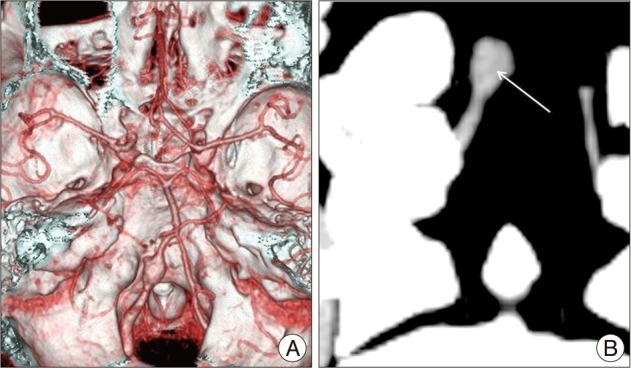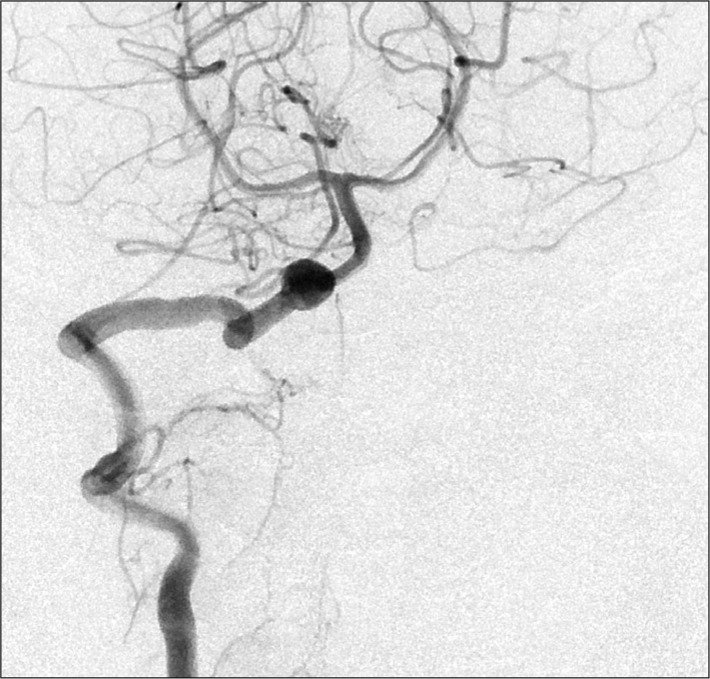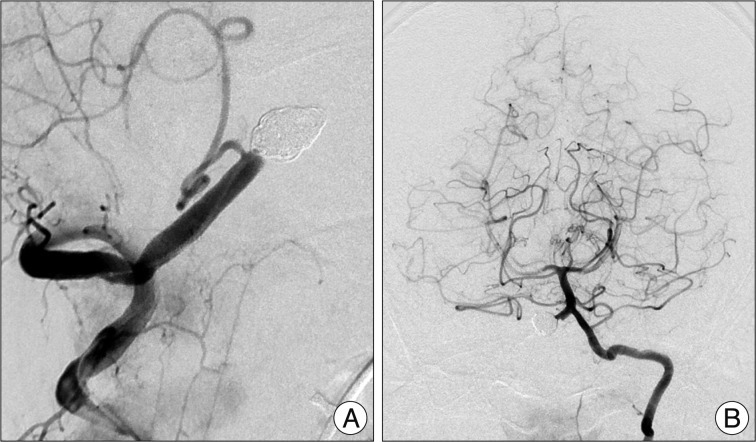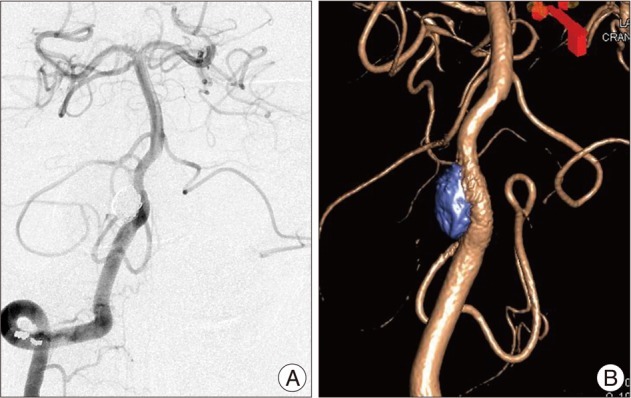J Korean Neurosurg Soc.
2012 May;51(5):301-304. 10.3340/jkns.2012.51.5.301.
Antegrade Recanalization of Parent Artery after Internal Trapping of Ruptured Vertebral Artery Dissecting Aneurysm
- Affiliations
-
- 1Department of Radiology, St.Vincent's Hospital, The Catholic University of Korea, Suwon, Korea. ihn@catholic.ac.kr
- 2Department of Neurosurgery, St.Vincent's Hospital, The Catholic University of Korea, Suwon, Korea.
- KMID: 2066931
- DOI: http://doi.org/10.3340/jkns.2012.51.5.301
Abstract
- We report a patient with a ruptured vertebral artery (VA) dissecting aneurysm that was treated by internal trapping of the aneurysm and parent artery using detachable coils with subsequent antegrade recanalization of occluded vertebral artery during the follow-up period. A 38-year-old man was admitted with a ruptured right VA dissecting aneurysm just distal to origin of right posterior inferior cerebellar artery. The dissected segment of the VA was occluded by coil embolization. The 14 months follow-up angiography showed that dissected aneurysm was completely occluded, but the parent artery was recanalized in an antegrade fashion. Based on this unique case, the authors suggest that careful angiographic follow-up of dissecting aneurysm is required, even in patients successfully treated with endovascular occlusion of the affected artery and aneurysm.
MeSH Terms
Figure
Cited by 2 articles
-
Endovascular Coil Trapping of a Ruptured Dissecting Aneurysm of the Vertebral Artery Using Detachable Coils and Micro-Tornado® Coils
Myeong-Soo Kim
J Cerebrovasc Endovasc Neurosurg. 2013;15(2):96-101. doi: 10.7461/jcen.2013.15.2.96.Endovascular Treatment of Intracranial Vertebral Artery Dissecting Aneurysms: Follow up Angiographic and Clinical Results of Endovascular Treatment in Serial Cases
Gi Won Shin, Hae Woong Jeong
Neurointervention. 2015;10(1):14-21. doi: 10.5469/neuroint.2015.10.1.14.
Reference
-
1. Baik SK, Kim YS, Lee HJ, Park J, Kang DS. Antegrade recanalization of parent artery in internal trapping of vertebral artery dissecting aneurysm : a case report. Surg Neurol. 2007; 68:108–111. discussion 111. PMID: 17586243.
Article2. Iihara K, Sakai N, Murao K, Sakai H, Higashi T, Kogure S, et al. Dissecting aneurysms of the vertebral artery : a management strategy. J Neurosurg. 2002; 97:259–267. PMID: 12186451.3. Jin SC, Kwon DH, Choi CG, Ahn JS, Kwun BD. Endovascular strategies for vertebrobasilar dissecting aneurysms. AJNR Am J Neuroradiol. 2009; 30:1518–1523. PMID: 19474118.
Article4. Kim BM, Shin YS, Kim SH, Suh SH, Ihn YK, Kim DI, et al. Incidence and risk factors of recurrence after endovascular treatment of intracranial vertebrobasilar dissecting aneurysms. Stroke. 2011; 42:2425–2430. PMID: 21778439.
Article5. MacKay CI, Han PP, Albuquerque FC, McDougall CG. Recurrence of a vertebral artery dissecting pseudoaneurysm after successful stent-supported coil embolization : case report. Neurosurgery. 2003; 53:754–759. discussion 760-761. PMID: 12943592.6. Mizutani T, Aruga T, Kirino T, Miki Y, Saito I, Tsuchida T. Recurrent subarachnoid hemorrhage from untreated ruptured vertebrobasilar dissecting aneurysms. Neurosurgery. 1995; 36:905–911. discussion 912-913. PMID: 7791980.
Article7. Mizutani T, Kojima H, Asamoto S. Healing process for cerebral dissecting aneurysms presenting with subarachnoid hemorrhage. Neurosurgery. 2004; 54:342–347. discussion 347-348. PMID: 14744280.
Article8. Rabinov JD, Hellinger FR, Morris PP, Ogilvy CS, Putman CM. Endovascular management of vertebrobasilar dissecting aneurysms. AJNR Am J Neuroradiol. 2003; 24:1421–1428. PMID: 12917140.
- Full Text Links
- Actions
-
Cited
- CITED
-
- Close
- Share
- Similar articles
-
- Endovascular Coil Trapping of a Ruptured Dissecting Aneurysm of the Vertebral Artery Using Detachable Coils and Micro-Tornado(R) Coils
- Stent-Jack Technique for Ruptured Vertebral Artery Dissecting Aneurysm Involving the Origin of Posterior Inferior Cerebellar Artery
- Early Rebleeding after Internal Trapping of a Ruptured Vertebral Artery Dissecting Aneurysm: A Case Report
- Bilateral Vertebral Artery Dissecting Aneurysms: A Long Term Follow-up Results of Microsurgical Trapping and Proximal Occlusion
- Endovascular Treatment of Intracranial Vertebral Artery Dissecting Aneurysms: Follow up Angiographic and Clinical Results of Endovascular Treatment in Serial Cases





